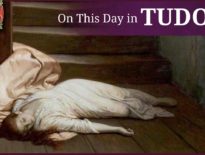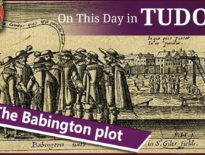On this day in Tudor history, 21st September 1557, Henry Pendleton, theologian, chaplain and friend of Bishop Bonner, was buried at St Stephen's, Walbrook, London.
Pendleton is known not only for his strong preaching, which led to him being shot at once, but also for his changing religious faith. He went from staunch Catholic to zealous Protestant to staunch Catholic, even taking part in disputations with his former friends and seeing them imprisoned and burnt.
Find out more about Henry Pendleton, his life, career and changing religious beliefs, in today's talk.
Also on this day in Tudor history, Sunday 21st September 1578, in the reign of Queen Elizabeth I, Robert Dudley, Earl of Leicester, married Lettice Dereveux (née Knollys) in a secret marriage at his house. So secret was it that he only told his chaplain and his friends the day before.
Leicester was marrying the woman Elizabeth I had dubbed "the she-wolf", so he knew that his queen would not be happy. Find out more about the secret wedding and Leicester’s bride, in last year’s video:
Also on this day in history:
- 1550 – Death of William Rugg (Repps), Bishop of Norwich. He was buried at the cathedral there. Rugg supported Henry VIII's quest for an annulment of his marriage to Catherine of Aragon and his subsequent supremacy, but his conservativism in other areas caused conflict between him, Thomas Cromwell and Thomas Cranmer. Rugg resigned his episcopate in January 1550 in return for pardons for his alleged support of the rebels in Kett's Rebellion.
- 1558 - Death of Charles V, former Holy Roman Emperor, from malaria at the monastery of Yuste in the Extremadura region of Spain. He had previously been suffering from debilitating attacks of gout which had necessitated him being carried around in a chair. Charles was buried at the monastery church, but later moved to the Royal Pantheon of El Escorial, the Royal Palace at San Lorenzo de El Escorial near Madrid.
- 1579 – Burial of Sir Edward Fitton, president of Connacht and Thomond, Vice-Treasurer and Treasurer-at-Wars during Elizabeth I's reign. He was buried beside his wife, Anne, at St Patrick's Cathedral in Dublin, Ireland.
Transcript:
On this day in Tudor history, 21st September 1557, Henry Pendleton, theologian, chaplain and friend of Bishop Bonner, was buried at St Stephen Walbrook, London.
You’ve probably never heard of Henry Pendleton, but I wanted to find out more about him when I found out that he is known for his changing religious beliefs, his strong preaching, and being shot at in Mary I’s reign. In Henry VIII’s reign, he was against the reformed faith which became known as Protestantism, then her supported it in Edward VI’s reign, and then he converted back to Catholicism in Mary I's reign. We might call him a pragmatist, a survivor, but it seems strange for someone who was a theologian, don’t you think?
Let me share some facts about Henry Pendleton…
• Pendleton’s birthdate is not known, but he came from a Lancashire family and studied at Brasenose College, Oxford – he got his BA in 1542, his Masters in 1544, and went on to get a degree and doctorate in theology in 1552. He was a fellow at Brasenose from 1542 to 1554, vice-principal from 1551 to 1552, and senior bursar there from 1553 to 1554.
• In Henry VIII’s reign, he preached against Lutheranism, but then embraced it in Edward VI’s reign. He was even appointed as an itinerant preacher, with four others including Laurence Saunders and John Bradford, by Edward, Earl of Derby “to preach the doctrines of the Reformation in the ignorant and popish parts of the country”. In 1552, also in Edward’s reign, Pendleton became vicar of Blymhill in Staffordshire.
• The Catholic Mary I came to the throne in July 1553 and martyrologist John Foxe, in his chapter of Laurence Saunders, writes of how Pendleton and Saunders met and discussed “what was best for them to do in so dangerous a season”. Foxe explains that Saunders was “so fearful and feeble-spirited, that he showed himself, in appearance, like either to fall quite from God and his word, which he had taught, or at least to betake him to his heels, and to fly the land, rather than to stick to his profession, and abide by his tackle” but that Pendleton was “bold in courage” and comforted Saunders and admonished him, telling him that he could not “forsake cowardly his flock when he had most need to defend them from the wolf; neither, having put his hand to God's plough, to start now aside and give it over; nor yet, (that is worst of all,) having once forsaken antichrist, to fall either himself, or suffer others, by his example, to return to their vomit again.” He even said “I will see the uttermost drop of this grease of mine molten away, and the last gobbet of this pampered flesh consumed to ashes, before I will forsake God and his truth.”
Strong words, yet, as Foxe tells, when the two men arrived in London, it was Saunders who stood firm “mightily beating down antichrist, and lustily preaching Christ his Master”, while “Pendleton the Proud”, as Foxe calls him, “changed his tippet, and played the apostatate, preaching, instead of sound doctrine, nothing almost but errors and lies, advancing antichrist, and overthrowing poor Christ with all his main” becoming “a sworn enemy of God”. Pendleton turned back to Catholicism, while Saunders stayed true to his faith and was burnt as a heretic in February 1555 as a result. I wonder how Pendleton felt on hearing about his friend’s execution, particularly as he then reaped the reward for his turn to Catholicism, being made prebendary of Reculverland, canon of St Paul’s, vicar of Todenham in Gloucestershire, canon of Lichfield, vicar of St Martin Outwich in London and then receiving the living of St Stephen’s, Walbrook.
• Pendleton was also appointed as chaplain to Edmund Bonner, Bishop of London and a man known as Bloody Bonner for his part in the persecutions of heretics in Mary I’s reign. While serving Bonner, Pendleton took part in disputations with Protestants who had been arrested, men like his fellow preacher John Bradford, who he visited in prison. According to John Foxe, Bradford reminded Pendleton of how Pendleton had once set forth the reformed faith “earnestly”, just like he did, and wanted to know what had moved his conscience to alter his faith. Pendleton asked him why he was imprisoned, and Bradford explained that it was due to his beliefs about the sacrament, that he denied that men were really receiving Christ’s body. Foxe writes “Here Master Pendleton, half amazed, began to excuse himself, if it would have been, as though he had not denied fully transubstantiation indeed” and the two went on to debate this. Bradford was burnt at the stake as a heretic in July 1555.
• Pendleton was famous for his preaching in Mary I’s reign, preaching to what was said to be 20,000 people on Easter Monday 1557. However, not everyone enjoyed his preaching. In his Ecclesiastical Memorials, John Strype records that when Pendleton preached at St Paul’s Cross on 10th June 1554 “a gun was shot off, and the bullet went over him, and hit the wall”. Strype adds that the shooter was not found and that it was not clear whether it was done by someone “out of detestation of Pendleton’s doctrine, or his person”, seeing as he had been a “zealous professor of religion in King Edward’s days, which he basely renounced under Queen Mary”.
• Pendleton contributed two homilies to Bishop Bonner’s 1555 Book of Homilies.
• Pendleton died sometime in September 1557 and according to John Foxe “at his death full sore repented that ever he had yielded to the doctrine of the Papists”. However, his biographer, LEC Wooding notes that “references to a work now lost, entitled A declaration of Hen. Pendleton DD in his sickness, of his faith in all points, as the Catholic church teachest, against sclanderous reports against him (London, 1557), suggest that this was a matter of some debate”. Did he change his faith once more at his death? We just don’t know, but perhaps so. He’d seen his friends and fellow preachers, Saunders and Bradford, go courageusly to their deaths strong in their Protestant faith.
• Pendleton was buried in his own church, St Stephen’s Walbrook, on this day in 1557.
• Minister Robert Halley, in his 19th century book “Lancashire, its Puritanism and Non-conformity”, describes Henry Pendleton as “an able man, handsome, athletic, possessed of a fine clear voice, mighty in the management of ready speech and powerful utterance” and writes of how “his preaching was in popularity and influence second only to that of John Bradford.”



Leave a Reply